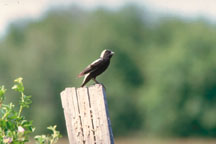|
Habitat Atlas for Wildlife at Risk
Bobolink
Dolichonyx oryzivorus

Bobolink
|

- Length: 15 cm.
- Males have a distinctive black body, buff crown
and extensive white markings on the wings and back.
- Females resemble large sparrows with buffy crown
stripes, buffy breast.
Status:
British Columbia Blue List
Special Significance
Bobolinks are small relatives of blackbirds, meadowlarks
and orioles that breed in scattered, small populations
throughout the Southern Interior in moist hayfields
in valley bottoms. Much of the Bobolink's habitat
is privately owned, so landowners are encouraged
to assist the continued survival of this bird by
delaying hay-cutting until after the bird's nesting
season.
Distribution
- In British Columbia, Bobolinks breed in localized sites in the
Southern Interior valleys north through the Cariboo-Chilcotin to
the Prince
George area.
- Elevational range is 300 to 800 metres.
Habitat
- Bobolinks inhabit open country with a preference for large hayfields,
moist meadows and weedy fields dominated by a mixture
of tall grasses; birds will also use marshes and other open places
in the autumn.
- Original prime breeding areas were damp meadows and
natural prairies with dense growth of grass and
a few low shrubs; today most Bobolinks nest in hayfields along valley
bottoms.
- Well-concealed nests are built in ground hollows frequently
at the base of tall weedy plants.
Reproduction
- Bobolinks arrive in May and depart in August.
- Birds lay 5-6 eggs in June; nestlings can be present
from mid-June to mid-July; young leave the nest
in 10 days before learning to fly.
- Males will mate with several females each season.
Food Habits
- Birds forage primarily on seeds when adults arrive in the spring
and on insects after young hatch.
- Caterpillars, grasshoppers and beetles are main components
of summer diet augmented with grain or weed seeds.
Interesting Facts
- The Bobolink has the longest migration of any North American songbird,
spending the winter months in the pampas (native
grasslands) of Brazil and Argentina.
- During courtship, male Bobolinks perform song displays
every few minutes, flying up to 40 metres in the
air while giving long, bubbling songs.
Threats
- Very few natural meadows and tall grass breeding
sites are left.
- Nests and eggs are destroyed in early summer when
hayfields are cut.
- Disturbance of nesting sites by humans or livestock.
Management Considerations
- Delay harvesting of hayfields until after mid-July.
- Protect known nest sites from human disturbance.
- Protect important habitat such as marshlands
and tall grass meadows.
|
References
1. Van Damme, L.M. 1995. Draft. Status Report on the Bobolink, Dolichonyx
oryzivorus, in British Columbia. Ministry of Water, Land and Air Protection,
Lands and Parks, Victoria, B.C.
2. Cannings, R.A., R.J. Cannings and S.G. Cannings.
1987. Birds of the Okanagan Valley, British Columbia. Royal British
Columbia Museum, Victoria, B.C.
|